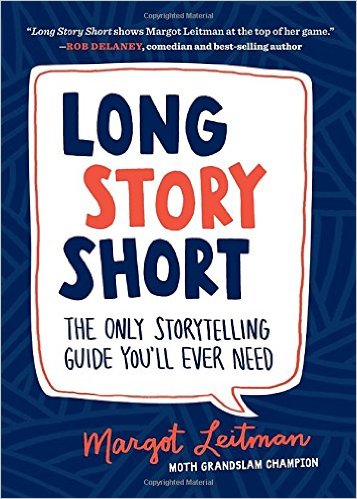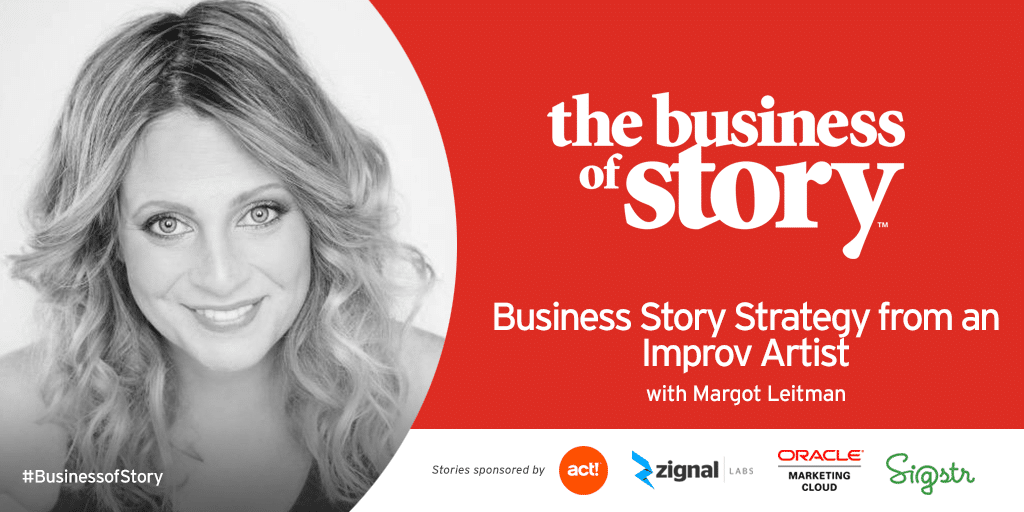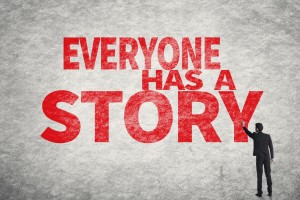Plus 6 great story insights and one terrific quote
Some of my clients and students tell me that they don’t lead interesting enough lives to have great stories. Nothing ever happens to them.
Do you feel like that?
My guest on this episode of the Business of Story podcast, Margot Leitman, author, teacher, professional storyteller and Moth GrandSLAM champ., provides a three-step process to pull your story together. You just fill in the blanks:
I am ____________.
I was ____________.
________________ is the story of my life.
Let’s give it a go.
I am a amateur pianist and composer, ad guy, professor of storytelling at ASU, and business story strategist for professional services firms. I am also husband to Michele, a talented interior designer with her own company called Grand Tour Interiors.
We have three industrious kids, who in their young adult lives have also embraced creativity. Our daughter, Corbin, is an event designer in San Diego for Pow Wow, and her work was recently featured in Huffington Post. Our son, Parker, is a motion designer in Hollywood working on a new game show for NBC, which will air in December. And our youngest son, Caed, a drummer and artist, works for KidneyPuncher. He routinely leads the organization in sales through his creative approach to customer service (I’ll hold that story for another post).
 I was a shoveler of horse shit (some, perhaps, say I still am). My first job was working for $2 per hour for Moe Morris Woodview Arabians in Woodinville, WA. I had 52 stalls to clean every day except Christmas, which made every 12/26 frightful.
I was a shoveler of horse shit (some, perhaps, say I still am). My first job was working for $2 per hour for Moe Morris Woodview Arabians in Woodinville, WA. I had 52 stalls to clean every day except Christmas, which made every 12/26 frightful.
In high school, I donned lederhosen and worked as a bus boy at the Schnitzelbank restaurant. We did an authentic German floor show twice each night on Fridays and Saturdays. We would sing, do a slap dance, and a wood chopping thing where we’d roll out a log and start hacking away on it in the middle of the parquet dance floor. We’d aim for diners’ Beetenbartsch soup with our flying wood chips.
I was also a radio DJ at WAZZU, a dancing number for the Washington State Lottery, a firewood entrepreneur, and a publicist working with Jack Nicklaus and Arnold Palmer for the Seattle Symphony Golf Classic.
Finding myself in strangely creative moments is the story of my life. Like the time my assignment on the Performance Committee at Washington Statue University was to keep Rodney Dangerfield entertained. We sat back stage drinking lousy black coffee, as he had just arrived hungover in white robe and block slippers from a long cross-state bus ride from Seattle. He was that night’s entertainment for Dad’s Weekend.
Or, when I was helping Steven Tyler of Aerosmith pick-up some props he was trying to juggle during one late, late party in Beverly Hills (We were hanging with Parker and Firegroove, who had been performing).
Or, when I had the honor to join acclaimed novelist, Margaret Atwood, for an intimate storytelling workshop at ASU. The other folks at the table were Ph.D’s, and the argument was that science fiction had no place in actual science.
I reminded the gathering that JFK was totally telling a science fiction story about sending a man to the moon and returning him safely home when he challenged America to win the space race. His fiction certainly inspired the science behind our space program, I mentioned. Even though Ms. Atwood gave me a subtle nod of touché, I was shunned by the academics from the remainder of the conversation.
My favorite moment is when a collection of professional musicians gathered at Hunnicutt Studios to record a jazz chart I wrote. That afternoon may have been the highest of my creative highs.
 As Leitman points out in her new book, Long Story Short: The Only Storytelling Guide You’ll Ever Need, and on our podcast, you can find amazing personal stories that you can use in business by going through this simple exercise. Each one of the items about who I am, who I was, and what seems to be the story of my life, is filled with numerous stories to tell that identify why I do what I do: help business leaders and communicators in professional services firms find their authentic brand stories that humanize their B2B offerings to drive the growth of their organization and people.
As Leitman points out in her new book, Long Story Short: The Only Storytelling Guide You’ll Ever Need, and on our podcast, you can find amazing personal stories that you can use in business by going through this simple exercise. Each one of the items about who I am, who I was, and what seems to be the story of my life, is filled with numerous stories to tell that identify why I do what I do: help business leaders and communicators in professional services firms find their authentic brand stories that humanize their B2B offerings to drive the growth of their organization and people.
Here are 6 of my favorite insights from our conversation and her new book.
- Visual aids in storytelling are like nude scenes in films: too much is overkill.
- People who think they have no stories to tell are simply numb to their own experiences.
- Revealing vulnerable moments from your everyday life almost always payoff.
- Find the recurring theme in your life, then look for the extremes.
- If you ain’t desperate at some point in you life, you ain’t interesting. – Jim Carrey
- Unless your tale contains a universal theme, it’s best left with your therapist or your best friend.
And finally, Leitman featured this quote from Charles Bukowski, in her book:
“If you’re going to try, go all the way. Otherwise, don’t even start. This could mean losing girlfriends, wives, relatives and maybe even your mind. And, you’ll do it, despite rejection and the worst odds. And it will be better than anything else you can imagine. If you’re going to try, go all the way. There is no other feeling like that. You will be alone with the gods, and the nights will flame with fire. You will ride life straight to perfect laughter. It’s the only good fight there is.”
Thank you, Margot, for joining us on Business of Story and showing us how story can ignite our businesses.












